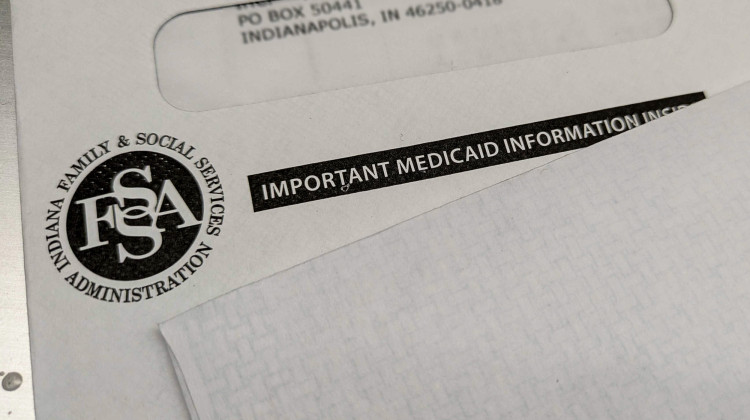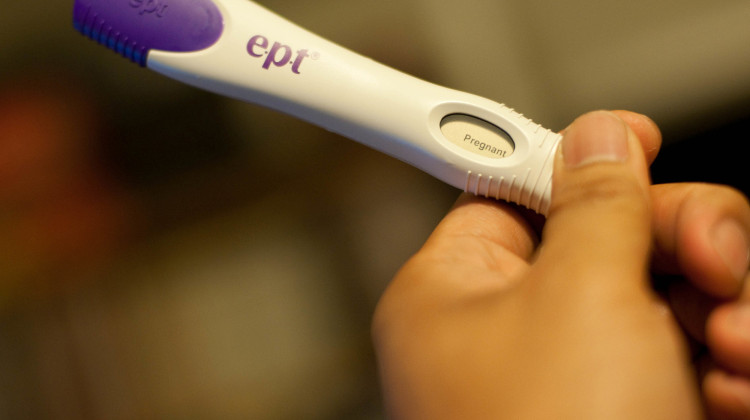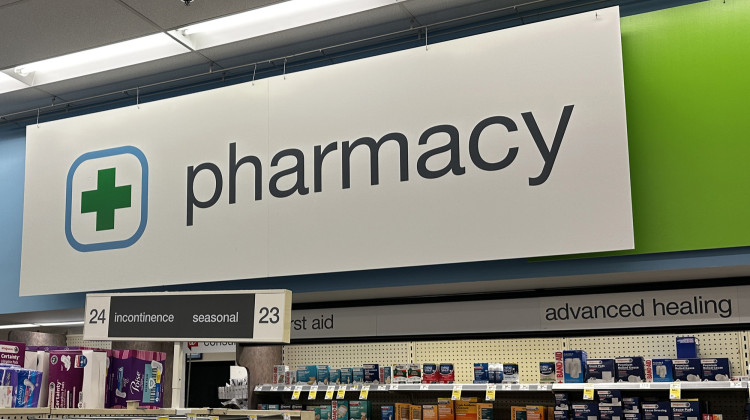
The state's reopening is contingent on maintaining hospital capacity and increasing testing for the virus.
Scott Cameron/IPB NewsThe Indiana State Department of Health reported 70 additional confirmed deaths over the weekend, bringing the state’s total to 1,132. The state announced nearly 20,000 total confirmed cases, with more than 108,000 Hoosiers tested.
Governor Holcomb Outlines How – And Why – The State Will Reopen
Gov. Eric Holcomb outlined his plan to reopen in-person business across the state. It will roll out in a five-stage process, with most of the state beginning Stage 2 on Monday.
The state’s timeline would lift all restrictions by July 4. But that could be extended.
The four main categories the state is looking at when deciding if and how to pull back on the reopening process focus less on the numbers of cases and deaths, and more on hospital capacity and testing for the virus.
The cases and deaths will increase as the state reopens. But Holcomb says the new partnerships to increase testing and contact tracing mean it can do so responsibly.
“And we’re taking the responsible steps in allowing ... folks to return to some normal aspects of their life,” Holcomb says.
Holcomb Apologizes For Failing To Follow COVID-19 Safety Precautions
Governor Holcomb is apologizing after he was photographed this weekend out in public without following proper COVID-19 safety procedures.
A selfie posted on an Indiana woman’s Facebook page – and shared widely by a local Democratic Party Twitter account – shows Holcomb taking a photo with the woman and her daughter, all of them without masks and well within six feet of each other.
In a statement, Holcomb says he left his mask in the car when retrieving takeout from a local restaurant – what he calls a lapse in his “usual vigilance.”
1,000+ Tyson Infections And One Hospital: Cass Co. Braces For Even More COVID Cases
Logansport and Cass County made national news Monday after officials announced an order tightening distancing restrictions on businesses. That came on the heels of more than 700 new cases of COVID-19 reported over the weekend, with many tied to the local Tyson Foods meatpacking plant.
Now, rural Cass County has the third-most cases of COVID-19 in the state.
Carmen Jones, Logansport Memorial Hospital's director of marketing and community relations, says more than 1,000 of those cases can be tied to the Tyson plant which employs about 2,200 people.
"The testing and investigation process with Tyson Foods has been run by the Indiana State Department of Health (ISDH),” Jones wrote in an email. “This process is still ongoing and independent of Logansport Memorial Hospital. We have been working with the Cass County Health Department and the ISDH to assist them as much as possible with this process. Before the site-based testing and investigation was launched, some Tyson employees were utilizing the walk-in respiratory clinic that we had established early on with the Cass County health department. That accounts for some overlap of numbers between the ISDH investigation and our tracking efforts."
Protesters Rally Across Indiana For Immigrant Worker Rights During Pandemic
Protesters across the state gathered in car caravans Friday in response to claims of "rampant workplace exploitation" of undocumented workers during the COVID-19 pandemic. They’re demanding driver's licenses, protection from deportation and access to stimulus aid packages.
The Cosecha Movement organized the demonstrations in Indianapolis and Elkhart. Participants hung banners from their cars and honked horns as they drove around the Statehouse and manufacturing facilities in Elkhart. They say immigrants are facing layoffs with no access to unemployment benefits or other ways to supplement lost income.
Jose Alvarez was one of the demonstrators who drove in the Elkhart caravan. He says many undocumented workers have been essential in keeping a steady food supply and critical manufacturing plants open throughout the COVID-19 pandemic.
New COVID-19 Testing Takes Aim At African-American Disparities
Black Americans across the country are dying from the new coronavirus at a much higher rate than whites. Experts have a lot of explanations, but they also say more data is needed. In Indianapolis, a new no-cost testing program hopes to increase COVID-19 testing in African American communities.
Marion County is setting up free test sites to address health disparities. It started Thursday in Arlington Woods, a predominantly African American neighborhood that is the county’s biggest hotspot for COVID-19 cases.
“Obviously this is a community and area that has health disparities. And so, so we’re here to serve the community,” Virgil Madden of the county’s public health department said as the testing site opened. More testing is important to get a clearer picture of the virus’ impact," he says.
In Marion County, black residents make up about 30 percent of the population. And early data shows they are almost twice as likely to be hospitalized or die from the virus, compared to white residents.
Breanca Merritt, director at the Center for Research on Inclusion and Social Policy at the Indiana University Public Policy Institute, says, “I was not really surprised about the numbers; we’ve seen similar trends in other major cities.”
Lafayette Farmers’ Market Officially Opens Under New COVID-19 Guidelines
The first Lafayette Farmer’s Market of the year opened at 8 a.m. Saturday morning, and market coordinator Rebecca Jones gave everyone the same greeting.
“Hi! Welcome to the market,” Jones said, to masked and unmasked customers, to families, and to customers out on their own. “We do ask that you enter and exit the market at the same point, which is right here.” (At the corner of 5th Street and Columbia Street.) “Each of our vendors do have their own lines, which is indicated by the orange tape.”
Jones explained that knots were tied in the tape at six-foot intervals, to show everyone where to stand as they waited to make a purchase.
READ MORE: Can I Go For A Walk? Here's What The Updated 'Stay-At-Home' Order Really Does
Join the conversation and sign up for the Indiana 2020 Two-Way. Text "elections" to 73224. Your comments and questions in response to our weekly text help us find the answers you need on COVID-19 and the 2020 election.
LEE MAS: ¿Puedo Salir A Caminar? Esto Es Lo Que Significa Una Orden De Permanecer En Casa
“Have a great time!” Jones said, and as people entered, she added their number to an app on her phone. Only 60 customers are allowed in at one time. The market is currently operating under a series of restrictions intended to mitigate the spread of COVID-19.
Typically, market vendors line both sides of 5th Street between Columbia and Main. On Saturday, 13 tents were staggered along the west side of the street, with orange tape corralling each vendor’s customers into separate areas. Orange tape along both sides of the street blocked people from stepping directly into the market space from the sidewalk.
Ball State President: Some Classes Will Be On Campus In Fall
Ball State University officials say they are planning for both on campus and online classes for the fall. The Muncie school wants to be ready in case some coronavirus restrictions are still in place.
“It is the overarching and paramount objective to prepare and to plan to resume appropriate academic and campus operations for the fall semester,” Ball State President Geoffrey Mearns says.
Mearns says, as of now, he expects to welcome students to campus in August.
“I think we will be on campus with some classes and with some operations. I think it would be foolish to predict that it would exactly replicate what campus would look like on March 1,” he says.
1-To-1 Student Device Plan Will Cost IPS $12M
Just two months ago, the notion Indianapolis Public Schools would purchase a device for every student was barely a consideration. The district was focused instead on providing a three-to-one student-to-device ratio, for laptops and tablets that students use during the school day.
Now, in wake of the new coronavirus and the closure of school buildings this academic year, district leaders say one-to-one access to technology is a top priority. IPS and other districts are preparing for scenarios where students could continue learning from home this next academic year, if the pandemic is not under control.
IPS leaders estimate they will spend $12 million to meet that goal and ensure each student has access to the internet by the fall. Around 40 percent of students cannot currently get online at home, according to district estimates.
So far, 3,700 Chromebooks and 900 MiFi mobile hotspot devices have been distributed to students. The district is now ordering 14,000 more Chromebooks for grades 3-12 and 7,000 iPads for grades K-2, at a cost of about $9.2 million, says Weston Young, chief financial officer. Plans are underway to purchase 9,000 additional wifi hotspots and related internet access.
Contact Lauren at lchapman@wfyi.org or follow her on Twitter at @laurenechapman_.
This is a rapidly evolving story, and we are working hard to bring you the most up-to-date information. However, we recommend checking the websites of the Centers for Disease Control and Prevention or the Indiana State Department of Health for the most recent numbers of COVID-19 cases.
 DONATE
DONATE







 Support WFYI. We can't do it without you.
Support WFYI. We can't do it without you.